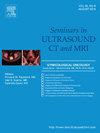Imaging Assessment of Prostate Cancer Extra-prostatic Extension: From Histology to Controversies
IF 1.9
4区 医学
Q3 RADIOLOGY, NUCLEAR MEDICINE & MEDICAL IMAGING
引用次数: 0
Abstract
Prostate cancer (PCa) is the most common non-skin malignancy among men and the fourth leading cause of cancer-related deaths globally. Accurate staging of PCa, particularly the assessment of extra-prostatic extension (EPE), is critical for prognosis and treatment planning. EPE, typically evaluated using magnetic resonance imaging (MRI), is associated with higher risks of positive surgical margins, biochemical recurrence, metastasis, and reduced overall survival. Despite the widespread use of MRI, there is no consensus on diagnosing EPE via imaging. There are 2 main scores assessing EPE by MRI: the European Society of Urogenital Radiology score and an MRI-based EPE grading system from an American group. While both are widely recognized, their differences can lead to varying interpretations in specific cases. This paper clarifies the anatomical considerations in diagnosing locally advanced PCa, explores EPE’s impact on treatment and prognosis, and evaluates the relevance of MRI findings according to different criteria. Accurate EPE diagnosis remains challenging due to MRI limitations and inconsistencies in interpretation. Understanding these variations is crucial for optimal patient management.
前列腺癌前列腺外延伸的影像评估:从组织学到争议。
前列腺癌(PCa)是男性最常见的非皮肤恶性肿瘤,也是全球癌症相关死亡的第四大主要原因。前列腺癌的准确分期,尤其是对前列腺体外扩展(EPE)的评估,对预后和治疗计划至关重要。EPE通常使用磁共振成像(MRI)进行评估,它与手术切缘阳性、生化复发、转移和总生存率降低等较高风险相关。尽管核磁共振成像已得到广泛应用,但通过成像诊断 EPE 仍未达成共识。通过磁共振成像评估 EPE 主要有两种评分方法:欧洲泌尿生殖放射学会(ESUR)评分和一个美国团体基于磁共振成像的 EPE 分级系统。虽然这两种方法都得到了广泛认可,但在具体病例中,它们之间的差异会导致不同的解释。本文阐明了诊断局部晚期 PCa 的解剖学考虑因素,探讨了 EPE 对治疗和预后的影响,并根据不同标准评估了 MRI 检查结果的相关性。由于磁共振成像的局限性和解释的不一致性,准确诊断EPE仍具有挑战性。了解这些差异对于优化患者管理至关重要。
本文章由计算机程序翻译,如有差异,请以英文原文为准。
求助全文
约1分钟内获得全文
求助全文
来源期刊
CiteScore
2.60
自引率
0.00%
发文量
49
审稿时长
6-12 weeks
期刊介绍:
Seminars in Ultrasound, CT and MRI is directed to all physicians involved in the performance and interpretation of ultrasound, computed tomography, and magnetic resonance imaging procedures. It is a timely source for the publication of new concepts and research findings directly applicable to day-to-day clinical practice. The articles describe the performance of various procedures together with the authors'' approach to problems of interpretation.

 求助内容:
求助内容: 应助结果提醒方式:
应助结果提醒方式:


